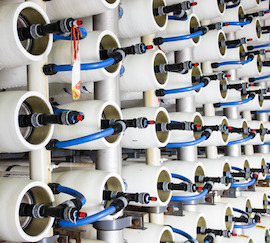San Diego recently invested a billion dollars into a desalination plant to convert Pacific Ocean saltwater into as much as 56 million gallons of drinking water per day. However, desalination is very energy intensive and produces waste products that can affect the environment. Could desalination help solve freshwater shortages in many parts of the globe? Here are some interesting facts about saltwater desalination that you should know.

Source
“The top three desalination countries are Saudi Arabia with 17 percent of global output, United Arab Emirates with 13.4 percent, and the United States with 13 percent.”
Source
Reverse-osmosis desalination was invented in California in the 1950s.
Source
“Some 80 percent of domestic water use in Israeli cities comes from desalinated water.”
Source
“There are about 15,000 plants producing desalinated water, most in the Middle East and North Africa—the largest is in Saudi Arabia.”
Source
“Desalinated water typically costs about $2,000 an acre foot — roughly the amount of water a family of five uses in a year.”
Source
“In order to supply water to 300,000 people, the Carlsbad desal plant will require the equivalent of a 31.3 megawatt power plant operating around the clock — enough electricity to power nearly 40,000 average California households for a year.”
Source
“Energy is the largest single expense for desalination plants, accounting for as much as half of the costs to make drinking water from the sea.”
Source
Desalination plants around the world consume more than 200 million kilowatt-hours each day.
Source
The Sydney Desalination Plant has cost around $2 billion although it hasn’t produced water since 2012 because dam levels are above 70%.
Source
It takes about 2 gallons (8 liters) of seawater to make 1 gallon (4 liters) of freshwater.
Source
Desalination plants operate in more than 100 countries.
Source
Desalination takes only a quarter of the electricity to generate drinking water as it did in the 1980s because of more efficient pumps, membranes and energy-recovery devices.
Source
The Jebel Ali plant in the United Arab Emirates can produce 564 million gallons of water a day from the sea.
Source
A thousand gallons of freshwater from a desalination plant costs the average US consumer $2.50 to $5, compared to $2 for conventional freshwater.
Source
